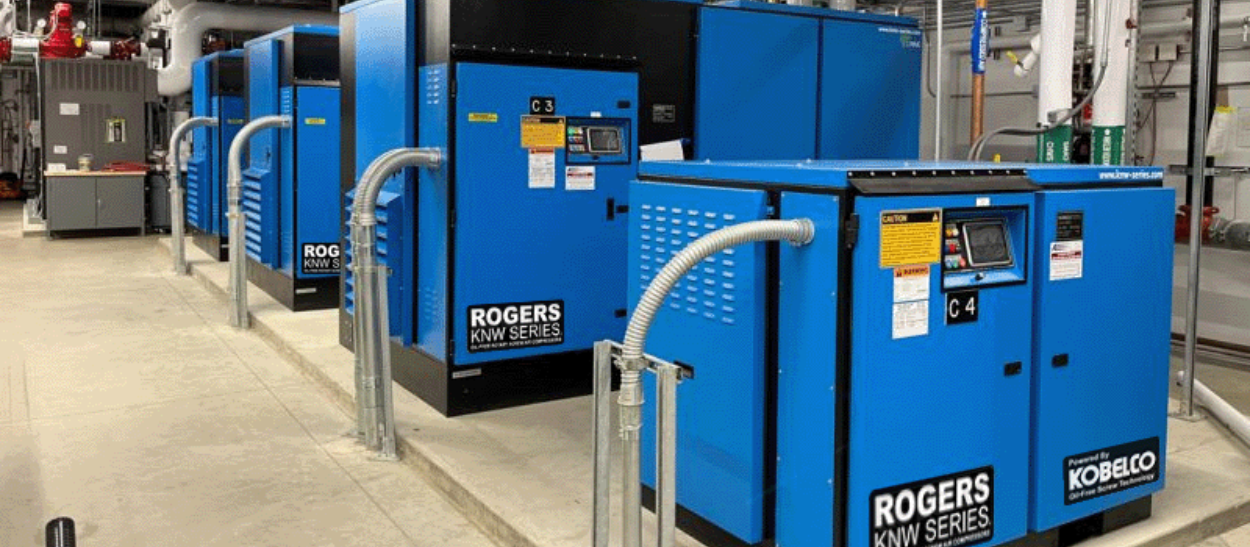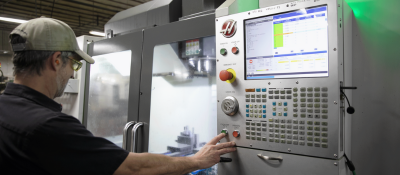Your Cart is Empty

What is a Compressed Air System?
Compressed air systems require many components to run smoothly. In order to get the most out of your compressor and avoid costly air quality issues, you’ll need more than just a compressor in your system to run your facility. In this article, we will break down each component so you know exactly what your system needs. To learn more about compressed air in general, start with these articles.
Estimate read time: 6 minutes
What is Compressed Air?
Compressed air is air that has been pressurized to a higher density than atmospheric air by mechanical means using an air compressor. It is a vital energy source used in a wide range of industries, from manufacturing and construction to food processing and healthcare. Compressed air is readily available, versatile, and can power tools and machinery safely in environments where electricity may pose a hazard.
The process begins when ambient air is drawn into a compressor and squeezed into a smaller volume, increasing its pressure. This high-pressure air is then stored in a tank or delivered directly through piping systems to power pneumatic tools or other equipment. Moisture and contaminants are removed from the air during and/or after compression to prevent damage to tools and ensure efficiency.
Why Do We Use Compressed Air?
Compressed air is commonly used for:
- Powering pneumatic tools – Compressed air is used to run drills, impact wrenches, nail guns, and grinders in automotive, construction, and manufacturing industries.
- Operating machinery – Many production lines and automated systems rely on compressed air to control valves, actuators, and other equipment and components.
- Cleaning surfaces and equipment – High-pressure air is used to blow off dust, debris, and particles in workshops and factories.
- Packaging and bottling – In food and beverage industries, compressed air powers filling, capping, and labeling machines.
- HVAC control systems – Compressed air is used in building management systems to operate thermostats, dampers, and air handling components.
CASE STUDY: ENGINEERING LABORATORY SWITCHES TO A RELIABLE COMPRESSED AIR SUPPLIER
Compressed Air System Components
When thinking about a compressed air system, the first thing that comes to mind is a compressor. But what else goes into your system? The typical clean dry air system includes:
- Compressor
- Wet air receiver
- Coalescing pre-filter
- Regenerative air dryer
- Particulate after-filter
- Dry air receiver
- Final filter (optional)

A compressed air system is more than just the air compressor. Receivers, piping, and air treatment equipment are all necessary in achieving quality compressed air.
The Compressor
Compressing air without an air compressor is quite difficult. But finding the proper air compressor for your needs can be tricky. Here are 4 common questions to ask while selecting a compressor:
1: How much air does your plant need?
Calculate the Cubic Feet per Minute (CFM) and Pounds for Square Inch (PSIG) requirements of all the tools and equipment requiring compressed air. The manufacturers of the equipment should have this information. Calculate the maximum operating pressure needed for the plant. Make sure to add 10-20 PSIG for pressure loss, depending on how much piping is present between the compressor and the users/tools.
Understanding your CFM and PSIG requirements directly influences the type and size of air compressor you’ll need. For instance, tools with high CFM demands may require a larger, rotary screw compressor for continuous operation, while intermittent-use tools might be well-served by a smaller reciprocating compressor. The maximum operating pressure, plus added buffer for pressure loss, ensures that the compressor can maintain consistent performance across the system. Choosing the right compressor technology helps avoid underperformance, excess energy costs, or equipment wear due to inadequate pressure or flow.
2: What elevation are you operating at?
Atmospheric pressure plays a critical role in selecting an air compressor. The higher the altitude, the lower the atmospheric pressure. Compressors need to work harder at higher altitudes to compress the same amount of air as a compressor at sea level. Maximum pressure might be limited depending on your specific compressor selected.
RELATED: HIGH TECH ELECTRONICS CUSTOMER GETS A “BOOST” TO VACUUM PERFORMANCE SAVING OVER $200K IN ENERGY & WATER COSTS
3: Do you need oil-free air?
Facilities in industries such as food & beverage, pharmaceuticals, or high tech require stringent air quality requirements. Known as ISO requirements, these dictate how much particulate, water, and oil can safely enter the end-use. These strict ISO-requiring applications (i.e. high tech, food, pharmaceutical, etc.) typically require oil-free air compressors as opposed to oil-lubricated units to remove oil contamination of the gas stream.
If your facility does not require clean, dry air, an oil-lubricated compressor may be a better option. Oil-lubricated compressors use oil to lubricate the components of the air compressor, extending component life and reducing noise and heat. Oil-lubricated compressors are suitable for many heavy-duty operations, such as lumber mills and most processes where the air does not come into direct contact with the product.

4: What type of cooling do you need?
There are advantages and disadvantages for both air-cooled and water-cooled systems.
Air-Cooled Systems
Air-cooling is the most common cooling system for the compressor. Air-cooled units are typically more cost-effective and do not require the environmental regulations for discharge water that water-cooled systems do. They require a well-ventilated, unrestricted area, and a cool source of air for the inlet.
Water-Cooled Systems
If ventilation in your plant is restricted, a water-cooled system may be better suited. The operating cost of a water-cooled compressor is typically higher than an air-cooled compressor due to the cooling water requirement and other treatment expenses associated with the cooling water.
For open water-cooled systems, the water must come from an outside source. This is typically from municipal water mains, wells, or even lakes and streams. The water may be required to be cooled to the desired temperature and can be costly to run.
Compressor systems can recirculate water to cut down on the cost of pumping in 100% outside water. In an open circulating system, water is re-cooled in a cooling tower, where air blows through a chamber to cool the water. Because of this, some water evaporates, while the rest is cooled to below the ambient temperature.
A closed system circulates water between the compressor and an external heat exchanger. The exchanger is also cooled, either by the surrounding atmosphere or an external water circuit. These circuits are filled with pure softened water. In climates where the water can freeze, adding glycol will prevent frozen pipes, but can affect the calculation of the system’s water flow requirements.
RELATED: HOW TO SELECT THE RIGHT AIR COMPRESSOR FOR A NEW PLANT
Air Receivers
Compressed air receivers are used to store compressed air and limit demand on the compressor. When a receiver isn’t properly sized, it can lead to the compressor running more often than is necessary. This can lead to a decrease in the system’s overall efficiency.
Compressor systems often have 2 receivers: a wet receiver and a dry receiver. Wet air receivers are connected to the compressor before the dryer. They store compressed, untreated air and are sized to the compressor’s capacity: approximately 1-2 gallons per CFM. A wet air receiver can reduce demand on the compressor to generate air, increasing the longevity of the compressor.
A dry air receiver is stationed after the dryer. This receiver holds the air after it has been filtered and dried, removing the water content, and may have a final filter afterward if the system requires it. The air that comes from the dry air receiver goes directly to the plant, so this receiver is sized to the specific system requirements.

Air Treatment
There are two main components to treating compressed air: dryers and filters. Dryers and filters are used to reduce moisture content and contaminants in the air system. When compressed air is not properly dried and filtered, it can lead to contamination of the end process and the piping, which can be very difficult to clean.
Dryers
Facilities typically use one of two types of dryers: refrigerated or desiccant-based regenerative.
A refrigerated dryer uses refrigerant to cool and dry the air coming from the compressor (and wet receiver tank). These dryers have a pressure dew point (PDP) between 37-42°F. The dried air leaving the dryer is then reheated to room temperature by the warm inlet air from the compressor. Refrigerated dryers have minimal dew point capacity, but can be a great option for facilities that don’t need extremely low dew points. The dryers can be cycling (turning on and off as needed), or non-cycling (running continuously).
Desiccant dryers remove moisture from the air using adsorption, a process where water sticks to the surface of a material; in this case, desiccant beads. Then the desiccant is regenerated with heat, running expanded dried air from the discharge (called purge) to be reused again. These dryers have very low dew points and are excellent for facilities needing to meet stringent ISO standards. They can have dew points as low as -100°F or lower and are an excellent choice for cold environments, as the air in the system will not contain water that can freeze. Desiccant dryers can purge the desiccant through purge air from the compressed air system itself, or from outside purge air that is heated externally.
RELATED: HOW TO SELECT THE RIGHT DRYER FOR YOUR AIR COMPRESSOR
Filters
Two types of filters make up the filtration component of a compressed air system: coalescing and particulate filters.
Coalescing filters remove liquids from the air, such as water, aerosols, lubricants, and oil. They can also catch a high amount of particulate. This liquid drops out of the filter, making the dryer’s work easier. These filters need to be replaced frequently, typically every 1,000 hours, to keep the system running smoothly.
Particulate filters remove dust and other harmful particulates from the air using a membrane that lets only the air through. These are typically used after a desiccant dryer to catch any remaining particulate, as well as dust from the desiccant medium itself as it breaks down over time.

Facilities such as hospitals (pictured above) require substantial filtration to keep the air as clean as possible.
Compressor Backup & Communication
System redundancy is almost always recommended in compressed air systems. If your compressor goes down, needs maintenance, or the facility needs more operating air, the backup compressor can kick on and keep you operating. Industries like healthcare especially benefit from this. In a hospital or lab, where lives are at stake, a breakdown or issue with a compressor can quickly become critical. Having redundancy means that the compressed air never needs to stop flowing.
If your system requires backup, redundancy, or additional capacity, you will need more than one compressor connected to your system. These can be set up to communicate directly through auto lead/lag or through a sequencer when connecting three or more compressors. This communication allows compressors to be turned on only as needed, which can increase system efficiency and save in energy costs.
Being able to tie your compressors together to work in unison is also a massive help. The compressors talk to each other in the system, turning on extra capacity when necessary.
Success Story: Utah Hospital Consolidates Air System
A hospital in Utah was experiencing performance issues while operating several different compressed air technologies at different pressures. Working with the hospital’s engineers, Rogers conducted an energy audit and detailed a plan to consolidate the system to one that would allow for future growth, redundancy, and smart communication that met NFPA-99 standards.
READ THE FULL CASE STUDY

Compressed Air System Design & Piping
Compressors produce a large amount of heat waste, so keep that in mind when designing your compressor room. You will need a source of clean inlet air & discharge air ducting, or consider a water-cooled machine. Implementing a heat recovery system is a great way to recycle that heat and save energy costs.
Three Important Factors of Compressor System Design
- Adequate space — Make sure you can move around the compressor. Think about the maintenance needs. Can the technician access every part of the system?
- Airflow — Compressor rooms can get very hot. Make sure there is plenty of airflow in the room. Installing louvers to control outdoor airflow will keep the room cool. If air-cooling a compressor isn’t a viable option, opt for a water-cooled system.
- Heat Recovery — Do you want to utilize the heat of compression elsewhere in your facility? Some facilities use this to heat office space or provide heat to other equipment in the plant.

Ducting is a great way to remove heat from an air-cooled compressor. The warm air can be recycled in other areas of the facility.
Air Piping Best Practices
- Select Appropriate Piping Materials — Choosing the right materials for compressed air piping is crucial for system efficiency and longevity. Materials like aluminum, copper, and stainless steel are often preferred due to their durability and resistance to corrosion.
- Proper Sizing of Pipe — Ensuring the correct diameter of piping minimizes pressure drops and maintains optimal airflow. Undersized pipes can restrict air flow and lead to increased energy consumption and reduced system performance.
- Strategic Layout and Installation — Designing a piping system with minimal bends and avoiding unnecessary fittings reduces turbulence and pressure losses. A looped system can provide balanced pressure and improved reliability.
- Regular Maintenance and Leak Detection — Conducting routine inspections to identify and repair leaks is essential. Even small leaks can result in significant energy losses over time, impacting operational costs.
- Monitor and Optimize System Performance — Implementing pressure gauges and flow meters helps in monitoring the system's performance, allowing for timely adjustments and ensuring the system operates within desired parameters.
RELATED: COMPRESSED AIR PIPING BEST PRACTICES: MATERIALS, INSTALLATION, AND MAINTENANCE
Building an Energy-Efficient Compressed Air System
Compressed air is inherently inefficient. 85% of the energy used to create compressed air is lost as heat. We have already mentioned ways to make your compressed air system do more work for you. Here are a few more recommendations to increase the energy efficiency of your compressed air system.
- Avoid using excessive air — when the compressor is not in use, turn it off. Running a compressed air system unnecessarily can cost you big money in the long run. Think of it like turning your car off when you park. You wouldn’t leave the car running for hours just because you’ll need it the next morning.
- Fix leaks — one surefire way to increase efficiency is to find and repair leaks. Leaks can account for 20% or more of system demands. The easiest repairs to make are replacing rubber hoses and quick connects. This can be easily done and will improve efficiency.
- Turn the pressure down — When an issue with an air tool occurs, many people’s first instinct is to turn up the pressure. Because of this, plants often run at a higher pressure than needed. Keeping compressed air flowing at proper pressures can help facilities save big over time. For every 2psi that the compressed air pressure is lowered, 1% of energy is saved. You’ll save 10% power just by turning the pressure of your air compressor from 120psi to 100psi.
- Perform regular maintenance — All rotating equipment requires periodic maintenance. Regular fluid and filter changes maximize longevity and uptime. Technicians can also diagnose and make adjustments to the system and fine-tune energy efficiency.
- Switch to Variable Frequency Drive (VFD) technology — A variable frequency drive compressor operates as-needed. The motor controls the air flow to match the demands of the facility, kicking into higher gear for peak demand times and switching off when air is not in use. VFD compressors are inherently more efficient than a fixed-speed drive, since they can match demand.
RELATED: 8 WAYS TO INCREASE THE ENERGY EFFICIENCY OF YOUR COMPRESSED AIR SYSTEM

With all the components to a compressed air system selected, it’s time to get working on the install. Not sure what you’re looking for? Speaking with an expert can help shed some light. Our compressed air system representatives know the right questions to ask and can make recommendations based on your system’s needs. Once your compressed air system is installed, our technicians will perform regular service, making sure your facility continues to run at peak capacity.
You May Also Be Interested In:
How to Justify Capital Investment for Air Compressor and Vacuum Pump Systems
Case Study: Organic Valley Keeping Local
This Article Reviewed By:
 |
Jackson Redline is a mechanical engineer and project manager working in the Engineered System Solutions team. Jackson started at Rogers Machinery fresh out of college and was recently recognized in Plant Engineering 2023 Leaders under 40. |





